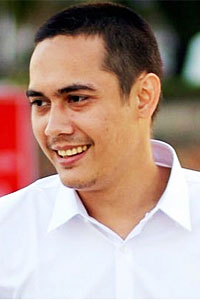The disappearance of the 1932 Siamese Revolutionary memorial plaque says a lot about anyone who removed it. But, first of all and let's get it of the way, removing the plaque does not mean that you are removing the history it represents.
Such an act alone cannot destroy what happened 85 years ago when Khana Ratsadon, the Peoples' Party, staged the revolution based on a bloodless coup which transformed the kingdom from an absolute monarchy to a constitutional one.
This is a history of all Thai people, not only for pro-democracy people or the red-shirt United Front for Democracy's activists. Fugitive and former prime minister Thaksin Shinawatra, whom many of the red shirt members are associated with, did not put the plaque there.
The memorial piece was laid there by Col Phraya Phahon Phonphayuhasena, one of the leaders of Khana Ratsadon, in 1936 to mark the spot where he and other revolutionaries rallied their troops in the Royal Plaza and read out a statement declaring the end of the absolute monarchy.

Erich Parpart is senior reporter, Bangkok Post.
Other historical monuments far larger in size than the 30cm brass plaque have been removed before, such as the Old Supreme Court Building which was torn down in 2013, and the first copy of Phraya Phahon's speech which was destroyed out of fear by his wife.
These previous disappearances did not remove the fact that Thai democracy was symbolically started on June 24, 1932, and the recent high public interest and debate on the plaque and the history it represents certainly are not the desired effects that the people who removed it hope for.
Thai society still remembers what happened and the new plaque that replaced the historical one may just be there to remind people of the disappearance of the original one.
Histories cannot be simply erased by burning books. This is the 21th century, so wake up and smell the internet.
So if removing the plaque does not erase history, what is wrong with it? The problems lie with how it was done and how the junta has dealt with dissidents afterward.
Tracing the missing plaque and finding clues about its disappearance have become an uphill task. Security cameras, installed by the Bangkok Metropolitan Administration at the traffic lights in the Royal Plaza area, were taken away just days before the item disappeared.
With no footage available, the public has no idea about how the incident took place. City Hall said the cameras were removed when workers started repairing the traffic lights, but didn't say who ordered they be removed.
Why is it that when anything important happens in Bangkok, the cameras seem to be either removed or broken?
Despite the lack of cameras, the area where the plaque is located is one of the most important historical sites in the country.
It is a key spot monitored for obvious security reasons by City Hall. But somehow no authorities saw the historical plaque being removed?
It might be important to note that the current governor of Bangkok is actually appointed by the junta.
Prime Minster Prayut Chan-o-cha used his sweeping powers under Section 44 of the interim constitution to appoint Aswin Kwanmuang as a replacement of former Bangkok governor Sukhumbhand Paribatra. Pol Gen Aswin is the first governor appointed to the position in 30 years.
Met with growing criticism from activists via complaints and an online petition, the military government, which claimed it has nothing to do with the disappearance, decided to unlawfully detain a transparency advocate, Srisuwan Janya, to make an example of him.
A small protest near the site was also broken up by police on Tuesday while its leader, unnamed, was taken into custody. Authorities then put up barricades around the new plaque to deny access to the public.
There have even been reports on social media and by Prachachat newspaper which claimed police ordered some onlookers to delete their photos of the new plaque.
Again, the police did not say which police commander or which agency ordered them to step in. If this is true, this act is also a human rights violation. Why are members of the public barred from taking a look at or photographing a public object in a public area?
If the military government did not do it, why are authorities side-stepping questions without explicit explanation? How come the police are busy blocking the site from public access instead of trying to find the culprits? The plaque is considered the city's property and there is a law against destroying public property.
The public's curiosity over the disappearance of the memorial plaque will not diminish easily. Authorities have to provide an explanation of the incident. They have to stop playing the "I don't know" card and come up with a better explanation than the "I was ordered to do so" robotic response we have seen of late.
The constitutional democratic system, which in Thailand was symbolically started at the site of the plaque, is instilled with checks and balances. These mechanisms need to pressure the government and the authorities be held to account for the saga of the missing plaque.
